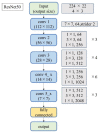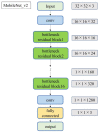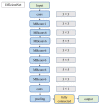Diagnosis of Cubital Tunnel Syndrome Using Deep Learning on Ultrasonographic Images
- PMID: 35328185
- PMCID: PMC8947597
- DOI: 10.3390/diagnostics12030632
Diagnosis of Cubital Tunnel Syndrome Using Deep Learning on Ultrasonographic Images
Abstract
Although electromyography is the routine diagnostic method for cubital tunnel syndrome (CuTS), imaging diagnosis by measuring cross-sectional area (CSA) with ultrasonography (US) has also been attempted in recent years. In this study, deep learning (DL), an artificial intelligence (AI) method, was used on US images, and its diagnostic performance for detecting CuTS was investigated. Elbow images of 30 healthy volunteers and 30 patients diagnosed with CuTS were used. Three thousand US images were prepared per each group to visualize the short axis of the ulnar nerve. Transfer learning was performed on 5000 randomly selected training images using three pre-trained models, and the remaining images were used for testing. The model was evaluated by analyzing a confusion matrix and the area under the receiver operating characteristic curve. Occlusion sensitivity and locally interpretable model-agnostic explanations were used to visualize the features deemed important by the AI. The highest score had an accuracy of 0.90, a precision of 0.86, a recall of 1.00, and an F-measure of 0.92. Visualization results show that the DL models focused on the epineurium of the ulnar nerve and the surrounding soft tissue. The proposed technique enables the accurate prediction of CuTS without the need to measure CSA.
Keywords: artificial intelligence; cubital tunnel syndrome; deep learning; ulnar nerve; ultrasonography.
Conflict of interest statement
The authors declare no conflict of interest.
Figures










Similar articles
-
Using deep learning for ultrasound images to diagnose carpal tunnel syndrome with high accuracy.Ultrasound Med Biol. 2022 Oct;48(10):2052-2059. doi: 10.1016/j.ultrasmedbio.2022.05.030. Epub 2022 Jul 20. Ultrasound Med Biol. 2022. PMID: 35868907
-
Ulnar Nerve Cross-Sectional Area for the Diagnosis of Cubital Tunnel Syndrome: A Meta-Analysis of Ultrasonographic Measurements.Arch Phys Med Rehabil. 2018 Apr;99(4):743-757. doi: 10.1016/j.apmr.2017.08.467. Epub 2017 Sep 6. Arch Phys Med Rehabil. 2018. PMID: 28888384
-
Degree of Accuracy With Which Deep Learning for Ultrasound Images Identifies Osteochondritis Dissecans of the Humeral Capitellum.Am J Sports Med. 2023 Feb;51(2):358-366. doi: 10.1177/03635465221142280. Epub 2023 Jan 9. Am J Sports Med. 2023. PMID: 36622401
-
Ulnar nerve and cubital tunnel ultrasound in ulnar neuropathy at the elbow.Arch Phys Med Rehabil. 2008 May;89(5):887-9. doi: 10.1016/j.apmr.2007.10.024. Arch Phys Med Rehabil. 2008. PMID: 18452736
-
Cubital tunnel syndrome - a review and management guidelines.Cent Eur Neurosurg. 2011 May;72(2):90-8. doi: 10.1055/s-0031-1271800. Epub 2011 May 4. Cent Eur Neurosurg. 2011. PMID: 21547883 Review.
Cited by
-
Quantitative Evaluation of Tendon Gliding Sounds and Their Classification Using Deep Learning Models.Cureus. 2025 Apr 6;17(4):e81790. doi: 10.7759/cureus.81790. eCollection 2025 Apr. Cureus. 2025. PMID: 40330348 Free PMC article.
-
Ulnar nerve thickness at the elbow on longitudinal ultrasound view in control subjects.Neurol Res Pract. 2023 Jan 26;5(1):4. doi: 10.1186/s42466-023-00230-2. Neurol Res Pract. 2023. PMID: 36698205 Free PMC article.
-
Role of high-resolution ultrasound and magnetic resonance neurography in the evaluation of peripheral nerves in the upper extremity.J Ultrason. 2023 Nov 23;23(95):e313-e327. doi: 10.15557/jou.2023.0037. eCollection 2023 Oct. J Ultrason. 2023. PMID: 38020515 Free PMC article.
-
Advances in Ultrasound-Guided Surgery and Artificial Intelligence Applications in Musculoskeletal Diseases.Diagnostics (Basel). 2024 Sep 11;14(18):2008. doi: 10.3390/diagnostics14182008. Diagnostics (Basel). 2024. PMID: 39335687 Free PMC article. Review.
-
Cubital tunnel syndrome: anatomy, pathology, and imaging.Skeletal Radiol. 2025 Jan;54(1):1-15. doi: 10.1007/s00256-024-04705-4. Epub 2024 May 18. Skeletal Radiol. 2025. PMID: 38760642 Review.
References
LinkOut - more resources
Full Text Sources
Medical

